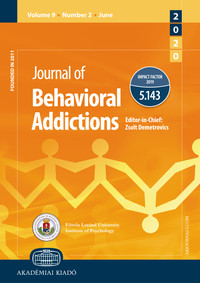Predictive utility of the brief Screener for Substance and Behavioral Addictions for identifying self-attributed problems
Predictive utility of the brief Screener for Substance and Behavioral Addictions for identifying self-attributed problems
Author(s): Magdalen G. Schluter, David C. Hodgins, Barna Konkolÿ Thege, T. Cameron WildSubject(s): Behaviorism
Published by: Akadémiai Kiadó
Keywords: addictive behaviors; scale development; screening; instrument validation; receiver operating characteristics
Summary/Abstract: Background and aims. The Brief Screener for Substance and Behavioral Addictions (SSBAs) was developed to assess a common addiction construct across four substances (alcohol, tobacco, cannabis, and cocaine), and six behaviors (gambling, shopping, videogaming, eating, sexual activity, and working) using a lay epidemiology perspective. This paper extends our previous work by examining the predictive utility of the SSBA to identify self-attributed addiction problems. Method.Participants (N = 6,000) were recruited in Canada using quota sampling methods. Receiver Operating Characteristics (ROCs) analyses were conducted, and thresholds established for each target behavior's subscale to predict self-attributed problems with these substances and behaviors. For each substance and behavior, regression models compared overall classification accuracy and model fit when lay epidemiologic indicators assessed using the SSBA were compared with validated screening measures to predict selfattributed problems. Results.ROC analyses indicted moderate to high diagnostic accuracy (Area under the curves (AUCs) 0.73–0.94) across SSBA subscales. Thresholds for identifying self-attributed problems were 3 for six of the subscales (alcohol, tobacco, cannabis, cocaine, shopping, and gaming), and 2 for the remaining four behaviors (gambling, eating, sexual activity, and working). Compared to other instruments assessing addiction problems, models using the SSBA provided equivalent or better model fit, and overall had higher classification accuracy in the prediction of self-attributed problems. Discussion and conclusions. The SSBA is a viable screening tool for problematic engagement across ten potentially addictive behaviors. Where longer screening tools are not appropriate, the SSBA may be used to identify individuals who would benefit from further assessment.
Journal: Journal of Behavioral Addictions
- Issue Year: 9/2020
- Issue No: 3
- Page Range: 709-722
- Page Count: 14
- Language: English

